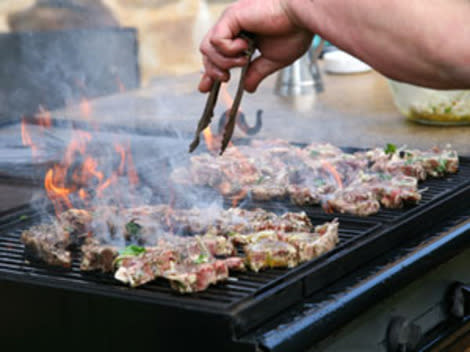Your Summer Grilling Guide

Cooking Perfection: Secrets to the Best Steaks, Chicken, Hamburgers, and Kabobs
1. Steaks: Steaks that are at least 3/4-inch to 1-inch thick won't dry out easily during grilling. Trim off excess fat and slash the fat edges at 1-inch intervals to prevent curling.
Turn your steak with tongs once, halfway through cooking (don't use a fork - it will pierce the meat and let the natural juices escape). Many factors can influence cooking time - including the weather, especially wind, when you're using charcoal - so test for doneness by cutting into the thickest part of the steak and checking its color.
2. Hamburgers: Make ground-beef patties about 1-inch thick - they're juicer than thinner patties. Ground meat is very susceptible to bacterial contamination, so be sure to cook your meat until it's at least medium-well done (160 degrees F on a meat thermometer inserted horizontally into the burger).
Related Link: How To Grill Vegetables
3. Poultry: Whether you're cooking chicken, duck, or turkey, the best way to test for doneness is with a thermometer. Breasts should be cooked to 170 degrees F; thighs and whole birds to 180-185 degrees F. You can remove poultry from the grill when it's 5 or 10 degrees below the recommended temperature, but be sure to let it stand about 10 minutes to allow the temperature to rise.
If you don't have a thermometer, remove the bird to a white plate and pierce with a fork. Any juice that comes out should be clear. If juice comes out pink, cook a little longer and check again. You can test cut-up pieces of chicken the same way.
4. Kabobs: Foods that are cooked together on the same skewer should heat quickly and take the same amount of time to cook. Foods with different cooking times, like vegetables and meat, should be grilled on separate skewers. Also, be sure to leave a little space between pieces on the skewer so the food cooks evenly.
If you like metal skewers, buy twisted or square ones, not round - the food will twirl on the skewers less and cook more evenly. If you're using wooden or bamboo skewers, shape isn't a factor. But soak them in water for at least 15 minutes before using so they don't burn. Just pat dry before putting food on them.
Related Link: A Guide To Lettuce
The Heat Is On: Grilling Temperatures
Q: How long does it take a grill to heat to the proper temperature?
A: Charcoal: Usually about 30 minutes. Wait until the coals are covered with a light gray ash before cooking.
Gas: Most gas grills preheat in about 10 minutes.
Q: How hot is my grill?
A: To estimate the temperature of your grill, carefully place your hand, palm-side down, about 6 inches over the heat source. Count the seconds ("one thousand one, one thousand two," etc.) until the heat forces you to pull your hand away. If you can keep it in place for 2 seconds, the grill is hot (375 degrees F or more); for 3 seconds, it's medium-hot (350-375 degrees F); 4 seconds, it's medium (300-350 degrees F); 5 seconds, it's low (200-300 degrees F).
Related Link: How to Find the Best Fruit of the Summer
Tricks of the Trade: Simple Tips to Make Grilling Easier
To lower or raise heat during charcoal grilling, adjust the racks, vents, and/or lid, or push coals apart or together.
Most foods should be cooked over moderate heat. Delicate items like bread should be placed near the edge of the grill (farthest from the coals) or on the rack above the cooking surface of a gas grill.
Uniform thickness makes for easy timing when cooking several items together, such as burgers.
Marinate foods in zipper-seal plastic storage bags for quick cleanups.
Brush leftover marinade on foods while grilling. Before using the marinade as a table sauce, boil it for at least 2 minutes to destroy bacteria.
Brush on thick marinades and sauces only during the last few minutes, to prevent burning.
To keep foods from sticking to the grill racks, rub the racks with vegetable oil or spray with nonstick cooking spray before heating them.
- by The Good Housekeeping Research Institute
More from Good Housekeeping:
